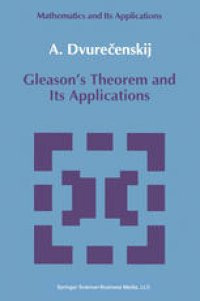
Ebook: Gleason’s Theorem and Its Applications
Author: Anatolij Dvurečenskij (auth.)
- Tags: Measure and Integration, Applications of Mathematics, Quantum Physics
- Series: Mathematics and Its Applications 60
- Year: 1993
- Publisher: Springer Netherlands
- Edition: 1
- Language: English
- pdf
For many years physics and mathematics have had a fruitful influence on one another. Classical mechanics and celestial mechanics have produced very deep problems whose solutions have enhanced mathematics. On the other hand, mathematics itself has found interesting theories which then (sometimes after many years) have been reflected in physics, confirming the thesis that nothing is more practical than a good theory. The same is true for the younger physical discipline -of quantum mechanics. In the 1930s two events, not at all random, became: The mathematical back grounds of both quantum mechanics and probability theory. In 1936, G. Birkhoff and J. von Neumann published their historical paper "The logic of quantum mechanics", in which a quantum logic was suggested. The mathematical foundations of quantum mechanics remains an outstanding problem of mathematics, physics, logic and philosophy even today. The theory of quantum logics is a major stream in this axiomatical knowledge river, where L(H), the system of all closed subspaces of a Hilbert space H, due to J. von Neumann, plays an important role. When A.M. Gleason published his solution to G. Mackey's problem showing that any state (= probability measure) corresponds to a density operator, he probably did not anticipate that his solution would become a cornerstone of ax iomati cal theory of quantum mechanics nor that it would provide many interesting applications to mathematics.
This volume deals with Gleason's theorem and Gleason's measures and indicates the many ways in which they can be applied. The book comprises five chapters.
Chapter 1 is devoted to elements of Hilbert space theory. Chapter 2 is devoted to quantum logic theory. Gleason's theorem is described and proved in Chapter 3, together with proofs for measures that can attain infinite values. In Chapter 4 the possibility of applying Gleason's theorem to the completeness criteria of inner product spaces is addressed. Chapter 5 discusses orthogonal measures and the unexpected possibility of describing states on Keller spaces, as well as other applications. Throughout the book, important facts and concepts are illustrated exercises.
For mathematicians and physicists interested in the mathematical foundations of quantum mechanics, and those whose work involves noncommutative measure theory, orthomodular lattices. Hilbert space theory and probability theory.
This volume deals with Gleason's theorem and Gleason's measures and indicates the many ways in which they can be applied. The book comprises five chapters.
Chapter 1 is devoted to elements of Hilbert space theory. Chapter 2 is devoted to quantum logic theory. Gleason's theorem is described and proved in Chapter 3, together with proofs for measures that can attain infinite values. In Chapter 4 the possibility of applying Gleason's theorem to the completeness criteria of inner product spaces is addressed. Chapter 5 discusses orthogonal measures and the unexpected possibility of describing states on Keller spaces, as well as other applications. Throughout the book, important facts and concepts are illustrated exercises.
For mathematicians and physicists interested in the mathematical foundations of quantum mechanics, and those whose work involves noncommutative measure theory, orthomodular lattices. Hilbert space theory and probability theory.
Content:
Front Matter....Pages i-xv
Introduction....Pages 1-5
Hilbert Space Theory....Pages 7-70
Theory of Quantum Logic....Pages 71-128
Gleason’s Theorem....Pages 129-201
Gleason’s Theorem and Completeness Criteria....Pages 203-244
Applications of Gleason’s Theorem....Pages 245-292
Back Matter....Pages 293-325
This volume deals with Gleason's theorem and Gleason's measures and indicates the many ways in which they can be applied. The book comprises five chapters.
Chapter 1 is devoted to elements of Hilbert space theory. Chapter 2 is devoted to quantum logic theory. Gleason's theorem is described and proved in Chapter 3, together with proofs for measures that can attain infinite values. In Chapter 4 the possibility of applying Gleason's theorem to the completeness criteria of inner product spaces is addressed. Chapter 5 discusses orthogonal measures and the unexpected possibility of describing states on Keller spaces, as well as other applications. Throughout the book, important facts and concepts are illustrated exercises.
For mathematicians and physicists interested in the mathematical foundations of quantum mechanics, and those whose work involves noncommutative measure theory, orthomodular lattices. Hilbert space theory and probability theory.
Content:
Front Matter....Pages i-xv
Introduction....Pages 1-5
Hilbert Space Theory....Pages 7-70
Theory of Quantum Logic....Pages 71-128
Gleason’s Theorem....Pages 129-201
Gleason’s Theorem and Completeness Criteria....Pages 203-244
Applications of Gleason’s Theorem....Pages 245-292
Back Matter....Pages 293-325
....